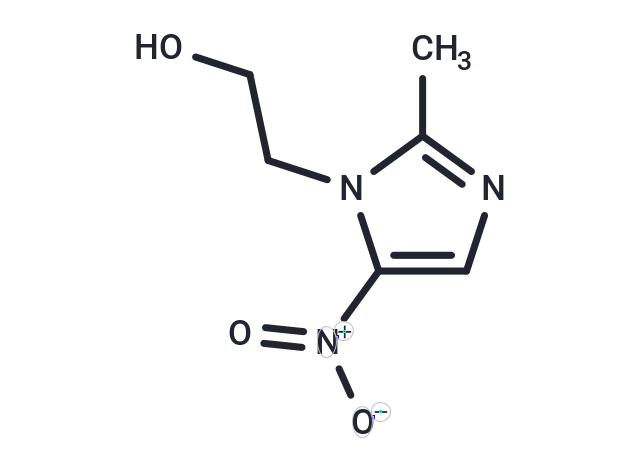Shopping Cart
- Remove All
 Your shopping cart is currently empty
Your shopping cart is currently empty

Metronidazole (Metronidazol) is a synthetic nitroimidazole derivative with antiprotozoal and antibacterial activities.

| Pack Size | Price | Availability | Quantity |
|---|---|---|---|
| 200 mg | $30 | In Stock | |
| 500 mg | $46 | In Stock | |
| 5 g | $55 | In Stock | |
| 10 g | $87 | In Stock | |
| 1 mL x 10 mM (in DMSO) | $30 | In Stock |
| Description | Metronidazole (Metronidazol) is a synthetic nitroimidazole derivative with antiprotozoal and antibacterial activities. |
| In vitro | Metronidazole is relatively inactive until it is metabolized within host or microbial cells. Metronidazole is activated when it receives an electron from ferredoxin or fla vodoxin that is reduced by POR in anaerobic or microaerophilic bacteria or luminal parasites. Metronidazole damages cells by forming protein and DNA adducts. [1] Metronidazole has activity against protozoans like Entamoeba histolytica, Giardia lamblia and Trichomonas vaginalis, for which the drug is first approved as an effective treatment. The activity of metronidazole against anaerobic bowel flora has been used for prophylaxis and treatment of patients with Crohn's disease who might develop an infectious complication. Metronidazole has played an important role in anaerobic-related infections. Metronidazole has notable effectiveness in treating anaerobic brain abscesses. [2] Metronidazole resistance tends to result from de novo mutation in the resident rdxA gene, rather than from lateral transfer of mutant rdxA (or other) genes from unrelated but Mtzr strains. Metronidazole partially inhibits growth stimulate forward mutation to rifampin resistance in rdxA(+) (Metronidazole(s)) and also in rdxA (Metronidazole(r)) H. pylori strains, and that expression of rdxA in Escherichia coli results in equivalent Mtz-induced mutation. [3] Metronidazole leads to apoptosis-like features in growing cultures of axenic B. hominis, including key morphological and biochemical features of programmed cell death (PCD), viz. nuclear condensation and nicked DNA in nucleus, reduced cytoplasmic volume, externalization of phosphatidylserine and maintenance of plasma membrane integrity with increasing permeability. [4] |
| In vivo | METHODS: To assay antimicrobial activity in vivo, Metronidazole (3-15 mg/kg) was administered once daily by gavage to M. tuberculosis Erdman-infected C57BL/6 mice. RESULTS: Metronidazole did not reduce the number of bacteria in the lungs of aerosolized infected mice during the active phase of the disease, during the control phase, or after long-term isoniazid treatment (Cornell model). Small but significant reductions were seen if Metronidazole treatment was given in the established chronic disease state 100 days after aerosol administration. [3] |
| Alias | Metronidazol, Flagyl, Anagiardil |
| Molecular Weight | 171.15 |
| Formula | C6H9N3O3 |
| Cas No. | 443-48-1 |
| Smiles | CC1=NC=C(N1CCO)[N+]([O-])=O |
| Relative Density. | 1.45 g/cm3 |
| Storage | Powder: -20°C for 3 years | In solvent: -80°C for 1 year | Shipping with blue ice. | |||||||||||||||||||||||||||||||||||||||||||||
| Solubility Information | Ethanol: < 1 mg/mL (insoluble or slightly soluble) DMSO: 60 mg/mL (350.57 mM), Sonication is recommended. H2O: 10 mg/mL (58.43 mM), Sonication is recommended. 10% DMSO+90% Saline: 3.2 mg/mL (18.7 mM), In vivo: Please add the solvents sequentially, clarifying the solution as much as possible before adding the next one. Dissolve by heating and/or sonication if necessary. Working solution is recommended to be prepared and used immediately. | |||||||||||||||||||||||||||||||||||||||||||||
Solution Preparation Table | ||||||||||||||||||||||||||||||||||||||||||||||
10% DMSO+90% Saline/H2O/DMSO
H2O/DMSO
DMSO
| ||||||||||||||||||||||||||||||||||||||||||||||

Copyright © 2015-2025 TargetMol Chemicals Inc. All Rights Reserved.